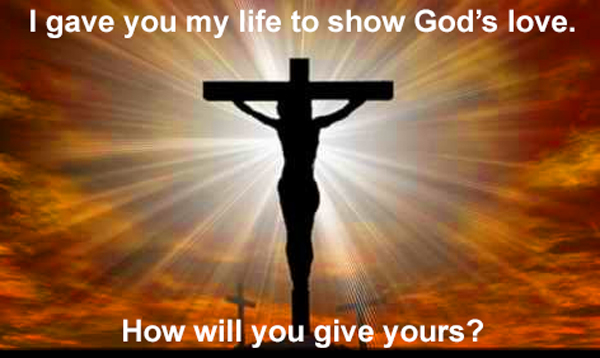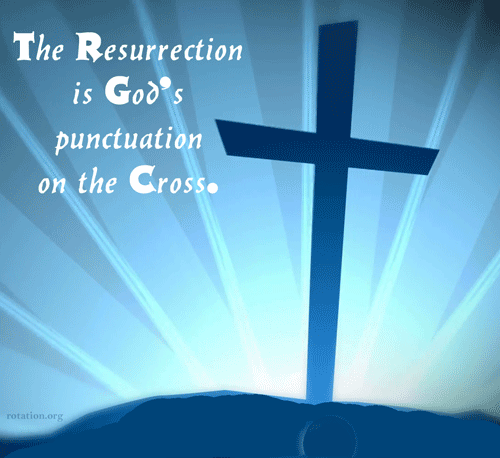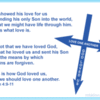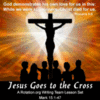Jesus Goes to the Cross
A Rotation.org Writing Team Lesson Set
Bible Background and Lesson Objectives

There is no way to exhaust the meaning of Jesus' Crucifixion. There are dozens of scriptures both Old and New Testament, 2000 years of Christian theology and tradition, and a myriad of dense words and metaphors all trying to explain what Paul described in 1 Corinthians 1:23 as a "stumbling block" –- something unexpected to all and incomprehensible to many. Thus, we write this Background and these lessons with humility — and with the needs of our children in mind.
Scripture
Mark 15:1-47
We have chosen Mark as our key scripture about this story because it is the least wordy (which is helpful when teaching children), and is the account upon which Matthew and Luke based theirs. The translation you use is your preference, but we suggest either the NIV, NRSV, or Good News.
One of the biggest teaching challenges is the sheer number of words and verses in this story (47 verses with approximately 920 words). Early on, we recognized the importance of creating a version that reduced the word count while keeping the essential scenes and dialogs, and coming up with activities for the reading of those verses. See the Lesson Summary for more details and the lessons for links to that condensed version.
We also recognized early on that the Gospel accounts of Christ's crucifixion do not explain it's meaning, and that we needed to keep the explanation SIMPLE for kids. For those reasons, we have chosen two key memory verses as the guiding influence of both this background and each lesson: Paul in Romans 5:8 and John in 1st John 4:9-11.
Memory Verse 1: Romans 5: 8
 "God demonstrates his own love for us in this: While we were still sinners, Christ died for us. (NIV)
"God demonstrates his own love for us in this: While we were still sinners, Christ died for us. (NIV)
Memory Verse 2: 1 John 4: 9-11
 "God showed his love for us by sending his only Son into the world, so that we might have life through him. 10 This is what love is: it is not that we have loved God, but that he loved us and sent his Son to be the means by which our sins are forgiven. 11 Dear friends, if this is how God loved us, then we should love one another. (Good News)
"God showed his love for us by sending his only Son into the world, so that we might have life through him. 10 This is what love is: it is not that we have loved God, but that he loved us and sent his Son to be the means by which our sins are forgiven. 11 Dear friends, if this is how God loved us, then we should love one another. (Good News)
Lesson Objectives
"Jesus Goes to the Cross" has two lesson objectives geared for children:
(1) To teach the basics of the story of the Cross—which we can't assume our students know. To that end, our lessons present the story first and foremost, each in a creative way.
(2) To teach the central meaning and life application of Jesus' crucifixion using uncomplicated language.
To that end, we have chosen two easily understandable explanations of the meaning and life application of the Cross—one from Paul and the other from John, to share with our children in each lesson:
"God demonstrates his own love for us in this: While we were still sinners, Christ died for us," ~Romans 5:8
...if this is how God loved us, then we should love one another. ~1 John 4:11
John's insight is especially helpful to teachers who want their students to know that the Cross isn't just about their own salvation, it demonstrates that salvation is also a way of living your life.
Children and the Violence of the Cross
The graphic and violent nature of crucifixion is an inescapable part of this story. God allowed Jesus to die a gruesome death to demonstrate the depth of God's love for us even as we did our worst to reject him. It is supposed to leave an INDELIBLE memory on those who see or hear it. There is no story or understanding of the Cross without understanding what Christ endured and sacrificed.
So how do we teach such an important story in an era when children are exposed to too much violence and most parents would prefer to shield them from such things? The answer is "carefully." Each of you and each of your parents may have a different opinion about what's appropriate to show. (How much blood? How much agony?) So talk, explain, and prepare children and parents. Be aware of those children whose emotional or intellectual tools are not ready to see or know or comprehend all that scripture details. See this discussion in more detail in our Video Workshop which offers several suggested videos for different sensitivities and age-groups
Background
The Challenge of Long Story
The story of the Cross is a long one for children. In addition to its many profound moments, it has several scenes and character changes. Each of the lessons in this set rises to the challenge of "length" in a creative way. We have also chosen Mark's Gospel version of the Cross story because it is the most concise.
About the Story of the Cross in the Four Gospels
The four Gospels generally agree on the events of the Crucifixion but there are some interesting differences regarding "who did what," and what Jesus said on the cross. For example, only Luke mentions that Jesus also went before Herod. And only Luke has Jesus saying, "Father forgive them..." Dr. Raymond Brown, the famous New Testament scholar, notes that the variations in the Gospel accounts of the Crucifixion are likely due to variations in the "core memory" about the last days of Jesus which circulated orally among the early Church.
"In the decades before the Gospels took their written form, the core was shaped and reshaped through preaching, scriptural reflection, theological argument, and the dynamics of storytelling itself." (From "The Death of the Messiah" published by Doubleday.) For more about these differences, google "synoptic problem."
Some of your children may have knowledge of those parts which aren't included in Mark. And while you can't stop to deal with them all, if they come up you should take a moment to briefly share "why" Mark's version is slightly different—in language that makes sense to children and doesn't side-track the direction or focus of the lesson.
Here are the Good Friday scriptures from Mark's Gospel.
- Mark 15:1-15
Jesus is bound by the Sanhedrin and taken to Pilate. The crowd chooses Barrabas. - Mark 15:16-20
The soldiers mock Jesus and beat him. - Mark 15:21-26
Simon of Cyrene is forced to carry the cross. Jesus is taken to Golgotha where he is crucified and a sign is placed over his head. - Mark 15:27-32
The crowd hurls insults. Others are crucified alongside him (but silent). - Mark 15:33-41
Darkness covers the land and Jesus cries out, "Eloi, Eloi...." then breathes his last. The curtain is torn in two and the centurion declares, "Surely this man was the Son of God!" - Mark 15:42-47
The Burial of Jesus in Joseph of Arimathea's tomb.
Familiar parts of the Crucifixion story NOT Included in Mark:
- Peter disowns Jesus. (Only in Luke 14:54f)
- Jesus before Herod. (Only in Luke 23:8f).
- “Father, forgive them, for they do not know....” (Only in Luke 23:34)
- Jesus' promise to the robber being crucified. (Only in Luke 23:40f)
- Jesus words: “Father, into your hands I commit my spirit.” (Only in Luke 15:46)
- Jesus' last words: "I am thirsty." "It is finished." (Only in John 19:28-30)
- Earthquake. (Only in Matthew 27:51)
- The spear in Jesus' side. (Only in John 19:35)
Given the number of passages about the cross to choose from, we have chosen to keep it simple and stick with Mark as the key text for this set. You may choose to mention others, but we caution teachers to avoid trying to pack too much in. There will be other opportunities for our kids to hear and learn about these other verses.
Explaining the Meaning of the Cross
Mark's Gospel account does not explain the Cross, so we have chosen two very important and memorable explanations provided by Paul and John.
Both Paul and John use rather simple words to explain the cross—which is super helpful to teachers of children! (Whereas words like "sacrifice" and "atonement" are more difficult to explain and understand with younger children.)
Both Paul and John use the words "demonstrate" or "show" (or "prove" or "reveal" depending on your translation) to explain what God was doing through Christ on the Cross. The Cross was the ultimate demonstration of God's forgiving love.
That is why you will see us using the words "demonstrate" and "show" in our lessons, and see that many of the lesson activities themselves have the kids "demonstrating" and "showing" ...instead of merely talking about the Cross.
Key Memory Verses About the Meaning of the Cross
Memory Verse 1: Romans 5: 8
 "God demonstrates his own love for us in this: While we were still sinners, Christ died for us. (NIV)
"God demonstrates his own love for us in this: While we were still sinners, Christ died for us. (NIV)
The NIV uses the word "demonstrates," whereas the NRSV uses the word "proves" and the Good News Translation uses "shows." All three are synonyms. On the cross, God was demonstrating, showing, revealing his love.
This link compares all the various translations of Romans 5:8.
Memory Verse 2: 1 John 4: 9-11
 "God showed his love for us by sending his only Son into the world, so that we might have life through him. 10 This is what love is: it is not that we have loved God, but that he loved us and sent his Son to be the means by which our sins are forgiven. 11 Dear friends, if this is how God loved us, then we should love one another. (Good News)
"God showed his love for us by sending his only Son into the world, so that we might have life through him. 10 This is what love is: it is not that we have loved God, but that he loved us and sent his Son to be the means by which our sins are forgiven. 11 Dear friends, if this is how God loved us, then we should love one another. (Good News)
The NIV and Good News translations use the word "showed," while the NRSV uses the synonymous word "revealed." Notice that they are also synonyms of "demonstrate, prove." which Paul used in Romans 5:8 ![]()
This link shows you 1 Jn 4:9 in all the various translations.
Could we have chosen other great verses? Yes, 2 Cor 5:19 for example. But in this lesson set, we have chosen focus over trying to cover the scriptural waterfront.
More about the Memory Verses as Key Explanations of the Cross
1. Jesus' Sacrifice on the Cross "Demonstrates" God's Love
According to Paul in Romans 5:8, the Cross "DEMONSTRATES" God's love for sinners.
"...at just the right time, when we were still powerless, Christ died for the ungodly. Very rarely will anyone die for a righteous person, though for a good person someone might possibly dare to die. " But God demonstrates his own love for us in this: While we were still sinners, Christ died for us." (Romans 5:8)

Jesus sacrifice on the Cross demonstrates the heart of God,
which is love and forgiveness,
...and that's GREAT NEWS.
2. The Cross Also Demonstrates How We Are to Love Others
According to John in 1 Jn 4:9-11, the Cross is not only an indelible message from God to humanity about God's loving heart, it is also an example to us, a call to love one another–to engage in Christ's on-going work of reconciliation. This is the way of the Cross.
The example of the Cross is beautifully stated by the Apostle John in his First Letter of John when he writes in verse 11, "Dear friends, if this is how God loved us, then we should love one another." In fact, all three verses are as good and age-appropriate explanation of the meaning of the Cross as you will ever find...

Challenges for Children
Children may ask, "Why did God let Jesus die?"
A surprising number of children (and adults) will conclude from our language and various Bible verses that "Jesus saved us from God." Where do they get this wrong idea? From the explanation that God demanded blood (punishment) for our sins, and that Jesus satisfied that blood demand by allowing God to punish him instead of us. (This is sometimes called "the theory of substitutionary atonement.") The problem of this explanation is that it pits God against Jesus. Whereas, Paul wrote in 2 Corinthians 5 that "God was in Christ reconciling himself to the world." Through the mystery of the Trinity, we understand that it was God on the cross demonstrating (showing, revealing, proving) the depth of his love for us, and not God punishing Jesus. Yes, our sins deserve punishment, but through Jesus, God did away with a religion that threatens punishment, in favor of one based on love and forgiveness. Theologians debate these nuances, but when teaching kids, we need to clearly be Trinitarian, not Old Testament.
Jesus chose to go to the Cross. It's why we titled this lesson set, "Jesus Goes to the Cross." Why did he choose to die? He told us in John 15:13 when he said, "Greater love has no one than this, than to lay down one’s life for his friends." What makes the Cross even more impressive is that he did it for his enemies too. Throughout his life and in his death, God demonstrated through Jesus his heart of forgiveness not punishment. Among other things, by going to the cross, God was in Christ putting an end to the "tit-for-tat" system of religion which had warped Israel's understanding of God and what God requires—And what does God require?
Will the Lord be pleased with thousands of rams,
with ten thousand rivers of oil?
He has told you, O mortal, what is good;
and what does the Lord require of you
but to do justice, love kindness, and walk humbly with your God.
Micah 6:7-8
"Why didn't God or Jesus stop what was happening?"
This is a common question and one which even the bystanders that day asked, according to Matthew 27:49. Of course, he could have. But it was God who set this story in motion. God knew what would happen. And God knew it would change the world. God was in Christ demonstrating not only his love, but the importance of obedience in following him, even if it leads to a cross.
This is also what it means to "take up your cross"—to demonstrate God's reconciling love by acts of reconciliation.
"Why were the people so mean?"
It's important that our kids understand that the people, priests, and rulers represent the sin of humanity. They are all of us. We are them. We reject God and turn to our own ways. We try to protect our positions of authority and traditions. Their rejection and hate make the love of God even more amazing. "Father forgive them," Jesus says upon the cross in Luke 23:34.
Why did the Jews hate him?
We reject the ancient animosity between Jews and Christians created by a twisted reading of this story. These were Jesus' people, just as we are his people. Humanity did this to Jesus. People trying to protect their positions and traditions did this to Jesus.
Verses of Note in Mark
Mark 15:1 "Early in the morning the chief priests met hurriedly with the elders, the teachers of the Law, and the whole Council, and made their plans." Having arrest Jesus on Passover night when crowds would have been dispersed, they now needed to have him tried and crucified on Friday by sundown when the Sabbath started and such things were not permitted. But why the rush? Why couldn't they have merely imprisoned him and had him killed later? We don't know.
Mark 15:11-15 “Crucify him!” This scene reminds us that Jesus did not appeal to many in the crowd, much less believe who he was. It also demonstrates that a murderer like Barrabas was the first set free by Jesus' sacrifice!
Mark 15:16-20 "When they had finished making fun of him..." Jesus could have responded, but he didn't. How do people make fun of Jesus today? How do you disrespect him?
Mark 15:29-30 "People passing by shook their heads and hurled insults at Jesus... He saved others, but he cannot save himself." People ask, why didn't Jesus save himself? But the better question is "how" was Jesus saving himself and others by not performing a miracle that would have taken him off the cross.
Mark 15:34 Jesus cried out with a loud shout, “Eloi, Eloi, lema sabachthani?” which means, “My God, my God, why did you abandon me?” It's important to teach children that Jesus is quoting Psalm 22 --which starts with this question and ends with affirmation and praise. As his life ended, Jesus was thinking of scripture and praising God. It's also important to note that some people thought he was calling Elijah because his name sounded like "Eloi" (God) to them. Many Jews expected Elijah to return to announce the Messiah, so when they heard Jesus quote Psalm 22, they were confused and probably excited.
Mark 15:38 "The curtain hanging in the Temple was torn in two, from top to bottom." The curtain separated the God's presence which was said to surround Holy of Holies in the Temple from the people. What does it mean that this curtain tore in two (opened)?
Mark 15:46 "Joseph bought a linen sheet, took the body down, wrapped it in the sheet, and placed it in a tomb which had been dug out of solid rock." Joseph was a member of the council and provided this last bit of respect to Jesus at the risk of his own position and reputation. We don't know what happened to Joseph after the resurrection, but it would be fun to imagine!
Atonement = set right, reconcile
Ask an adult member if they believe in the "Atonement" and they will say, "yes." Ask them to explain it, and you are likely to hear mumbled catchphrases. This is why we have chosen the words of Paul and John as our memory verses and explanations of the cross. They are plain and understandable --even to adults! So as we digress below into some theological vocabulary, keep in mind that church language often sounds like "Greek" to kids and adults.
"Atonement" is the general theological term used to describe what Jesus accomplished by sacrificing his life on the Cross. And as 1 John 4 pointed out, "atonement" is also what we are to practice in response to the Cross. There are theological debates about the best way to describe Christ's atoning sacrifice. Your tradition may use different words or emphasis. The following is intended to be general.
"Atonement" is an old Middle English word that originally meant "to make one," "to restore," "reconcile," "to make whole." The Hebrew synonym for this English word and concept is SHALOM, which means, "make peace, restore." Jesus spoke words of atonement throughout his life, and his death was atonement in action. We are called to demonstrate Atonement just like God demonstrated it through Jesus' sacrifice on the Cross. Paul's famous explanation in 2 Cor 5:19 captures this same meaning: "God was in Christ, reconciling (atoning) the world to himself..."
"Payment" for sins is another popular and biblical metaphor for understanding Jesus' atoning death—that Jesus "paid the price" for our sins to God. The idea comes from the Old Testament sacrificial system and scriptures which taught that forgiveness came when you paid God for your sins with offerings, including the offering of animals (blood). In keeping with this imagery, Jesus became "The Lamb of God"—the perfect sacrifice, and final sacrifice which ended the need for further animal sacrifices. His "blood" ended the need for more blood. Suffice to say, these are can be difficult ideas for children to contemplate. Some churches and denominations emphasize this traditional "blood" atonement way of describing God's reconciling work.
"Ransom" is another biblical word and idea found in many Old Testament scriptures that is often used to describe what Jesus' death accomplished. It is also found in Jesus' words as reported in Matthew 20:28 and Mark 10:45:
"...just as the Son of Man did not come to be served, but to serve,
and to give his life as a ransom for many.”
Paul echoes these words in his first letter to Timothy (2:6) when he describes Jesus as the one "who gave himself as a ransom" and added the immensely hopeful phrase "for all people." (Whereas Matthew and Mark only said, "for many." Interesting!) "Ransom" can mean "paying a price," but ransom can also mean "rescue" and "liberate," and thus, the "Ransom Explanation of the Atonement" is not necessarily the same as "Payment" or "Blood Atonement" explanations. Children may struggle with the idea that Jesus had to pay God a ransom—as do many adults! (Especially when you consider the Trinitarian paradox this language presents: Was God in Christ paying himself?)
"WHO" was demanding ransom or payment is a matter of debate in some traditions. One interpretation is that only sacrifices could "ransom" us from the bondage of sin by granting us forgiveness. Another interpretation, based in part on words from prophets like Micah quoted below, is that it was the Old Covenant's Temple sacrificial system and priests who demanded payment on God's behalf, and whereas, what God wanted was for his people to walk in justice and love. In this way of thinking, Jesus' sacrifice on the Cross was God's correction or end to the "Old Covenant" way of thinking about our relationship with God, rather than what some say is a "fulfillment" of it. (A debate which rages on.)
Regardless of where you fall in these interesting debates, Jesus' death put an end to the "transactional" way of thinking about God's love, and instituted a Table at which all are welcome. (Paradoxically, Jesus' "payment" put an end to the idea that God needs paid. That confuses adults let alone children!)
Above all other explanations and theological arguments, the Cross is simply and profoundly a demonstration of the love of God in such a manner that it stands as the single most talked about event in history.
This simple explanation has been echoed by theologians across the ages. As William Barclay, the 20th Century's great Bible commentator, wrote in his now famous "Daily Study Bible," this focus on love is "of extraordinary importance."
There is one thing to note here of quite extraordinary importance. Paul is quite clear that the whole saving process, the coming of Christ and the death of Christ, is the proof of God's love. Sometimes the thing is stated as if on the one side there was a gentle and loving Christ, and on the other an angry and vengeful God; and as if Christ had done something which changed God's attitude toward men. Nothing could be further from the truth. The whole matter springs from the love of God. Jesus did not come to change God's attitude toward men; he came to show what it is and always was. He came to prove unanswerably that God is love.
Stay Cross-Centered
Some churches and Christians prefer to quickly step past the Cross and get to Easter. The Cross is too violent, too sad, and too complicated, whereas Easter is the happy-ending people long for. Is it any wonder why Paul wrote that "Preaching Christ crucified" is a "stumbling block"? (1 Corinthians 1:23) And yet, the Cross is what the Resurrection confirms. The Resurrection is what brings us back to understand the Cross.
The Cross isn't a prelude to the Resurrection.
The Cross is the message Jesus rose to confirm.
(No, you are not seeing things. That is a round stone and slightly open tomb punctuating the bottom of the cross like an exclamation point. Share this with your students for discussion.)
Every Christian, church, and denomination has its preferences and habits when it comes to the vocabulary and emphasis about the Cross. Discuss yours with your pastor and fellow teachers, and keep in mind the importance of "keeping it simple" and staying focused on the Cross as the ultimate demonstration of God's love so that your kids don't stumble over dense theological concepts and misinterpret what God was doing. Resist the temptation to rush to or tack on a "happy Resurrection ending" to the story. For it is at the foot of the Cross where we learn the true depth of God's love for us—that Christ died while we were still sinners, and learn that we too are called to live lives of sacrificial, reconciling love.
Written for the Rotation.org Writing Team by Rev. Neil MacQueen (PCUSA)
with input from Writing Team members, Anne Camp, Carol Hulbert, Jaymie Derden, and Amy Crane. Edited by Luanne Payne.








